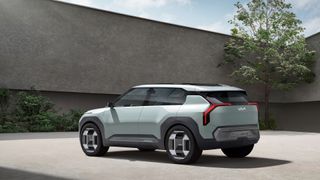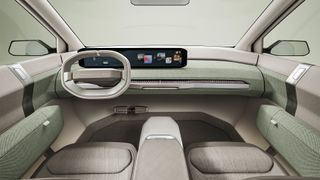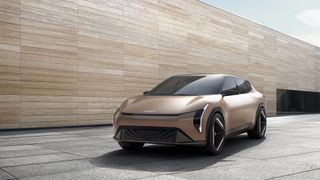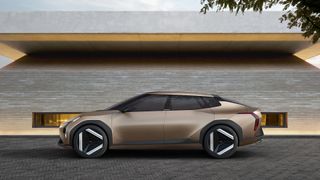Kia bets all on electric and unveils EV3 and EV4 concepts
As we rush towards the 2030 deadline imposed by many automakers, where the internal combustion engine will be effectively eradicated, the rate at which we will see new electrified cars will only increase.
Kia, which plans to sell at least 1.6 million electric vehicles by that date, has made its intentions very clear. At its inaugural EV Day, aptly named, which the company plans to hold annually to openly talk about its upcoming vehicles, it launched two brand new concepts: the Concept EV3 and Concept EV4, while confirming the specifications of its already announced EV5 SUV.
As if that wasn’t enough, the company also announced that the EV2, which will be the smallest electric car in its dedicated EV range until the arrival of the EV1, is almost in production and will be launched in 2026.
While we were given a sneak preview of EV2 in Korea, we were not given any media footage and are not allowed to provide any specific details until it is officially revealed. We did take a close look at EV3 and EV4, though, so here’s everything we know about Kia’s future cars.
Kia Concept EV3
This Compact Utility Vehicle (CUV) takes many of the slick design features of Kia’s massive EV9 and shrinks them down into a smaller, city-friendly package. It’s a beautiful piece of design, with imposing wheels that fill square wheel arches, a windscreen pushed all the way forward to increase interior space and a long sloping roofline that compliments some of the sharp angles.
Inside it is all very minimal and has the pure softness of a modern living room. Attention is paid to the choice of materials here, with many 3D knitted surfaces and biomaterials replacing traditional, washable PU and leather.
Aside from the sliding interior tables and the sleek integration of some equally minimalist digital displays, perhaps one of the coolest features is the rear seat. Not only is this a small bench for the rear passengers, it also folds upright and has a slide-in mechanism on the base for storing e-bikes or electric scooters.
When securely mounted and secured, the bench seat charges these devices using the Concept EV3’s Vehicle-to-load (V2L) functionality.
Kia Concept EV4
Intended to “redefine the sedan,” this unconventional four-door sedan is slightly longer than the current Tesla Model 3, but has seriously genre-breaking styling. A low nose rises to long, angular flanks, while a neat roof spoiler and elongated rear end give it the feel of a speedtail at the rear.
It’s an aggressive new face for Kia, seen across its current range of concept cars, and it features vertical LED headlights at the very edge of the bumper that lead lower down to the brand’s signature Starmap lighting.
There are some nice touches inside, but it’s also worth noting that Kia chief designer Karim Habib, and the help of his interior team, have opted for very minimalist cabins across the entire line of EV concepts, with infotainment technology taking a backseat. .
“The idea was to create an environment that would de-stress the occupants and bring people closer together,” Habib explained during a quick walk through the concept car.
To do this there’s a rear seat, a bit like that of the EV3, but it’s larger and doesn’t fold to accommodate eBikes. Up front, there is a distinct lack of air conditioning vents as they are hidden within the dashboard.
When turned on, these pin-shaped vents slide out, light up, and then gently swing back and forth. Of course, this is a feature we’re unlikely to see in a final model, but it’s a good indication of how clean the final interior will be.
“We wanted to create something called ‘Mind Modes’ in Concept EV4,” Habib explains. “These modes will change the color of the interior and the mood of the lighting. The lighting can glow red when the driver needs to concentrate, or switch to green and blue to create a much calmer environment.”
These ‘Mind Modes’ affect those waving A/C exhausts as they too light up and put on a show.
As we mentioned earlier, infotainment is limited to a discreet dual-screen setup, embedded in the dashboard. No huge tablet-like controls here. When questioned about this, Habib says that in his concept “luxury is in the tactility” and not necessarily in obvious technology. “Shy tech,” VP for interiors Jochen Paesen calls it.
The tactility referred to is the sheer amount of different fabrics and woven knits covering most surfaces. The cushions scattered across the back seat are made from mycelium, a natural fungal thread harvested from the roots of mushrooms, while other areas have used recycled plastic, hemp and even linseed.
Will these yield production?
According to Kia, these are very close to the final production models, and as they will be released in the coming years. So it’s safe to say that there will likely only be minor changes to the cars that go on sale.
Furthermore, Kia has said that its range of upcoming EVs will cost between $35,000 and $50,000, meaning the EV4 will have a price tag that will make it very competitive. We can even predict that the launch will be slightly cheaper than the Model 3, just to spice things up.
However, no mention has been made of range and charging times, although we do know that the E-GMP platform used here will feature a 400V electrical system, as opposed to the fastest 800V system seen in the EV6 and EV9.
This means longer charging times, but this is done to keep the overall costs down.





